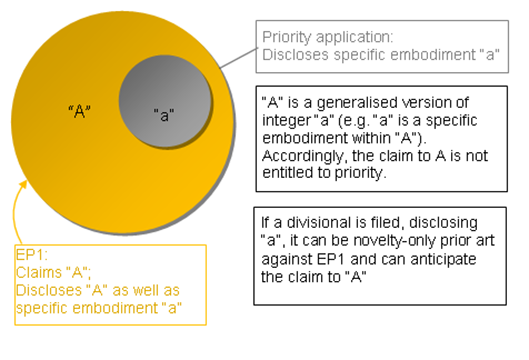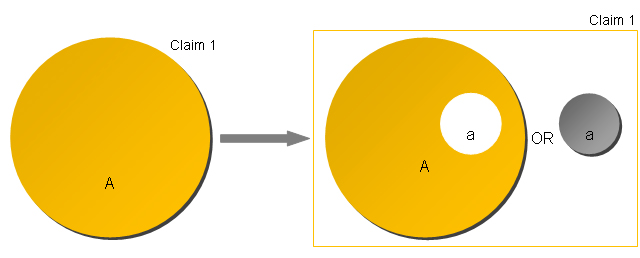10/06/2013
In the February 2012 issue of the CIPA Journal, the concept of a “poisonous divisional” was raised. In brief, the proposition was that in certain limited circumstances, a European divisional application could be Art. 54(3) (i.e. novelty-only) prior art against a claim in the parent which was not entitled to priority. The proposition has since been confirmed by the EPO Board of Appeal in T 1496/11.
An “antidote” was proposed, which required a particular way of construing the parent claim, and which allowed EP applicants (and more importantly patent attorneys) to sleep a little easier. However, the recent UK High Court decision in Nestec v Dualit perhaps casts doubt on the efficacy of the antidote.
Divisional Collision
The following diagram briefly explains a scenario in which a parent application might collide with a later filed divisional:

Although the claim of EP1 lacks priority, the claim may still be valid (assuming no other prior art, and assuming the priority application is not a published EP application).
However, if a divisional application is filed which discloses the same subject matter “a” as the parent, there can be a problem. The divisional application will be published, and can therefore be prior art under Art 54(3) EPC (for novelty only) against the parent, to the extent that the priority date of the subject matter in the divisional is earlier than the priority date of the claim of EP1. Thus, since “a” in the divisional is entitled to the priority date of the priority application, whilst the claim to “A” is not entitled to priority, the proposition is that the claim to A is anticipated by the divisional application.
To our knowledge, this proposition has yet to be tested in the UK courts. However, the EPO Boards of Appeal have found that the concept is real in T 1496/11 (unpublished and not marked for distribution). In this decision, the Board confirmed that a divisional application could indeed anticipate a claim on the parent, where that claim was not entitled to priority but where subject matter falling within the claim was disclosed in the priority document. In this case, the parent claim had been generalised relative to the disclosure of the priority document; thus, it was found to lack priority. The divisional application disclosed subject matter which was disclosed in the priority application, and for that subject matter it was therefore entitled to priority. Accordingly, that subject matter in the divisional application was Art. 54(3) prior art (i.e. for novelty only) against the parent claim, and the parent claim was held to be anticipated.
In the case in question, the problem could be avoided: the patentee limited the claim so that it was entitled to priority, and the divisional was therefore no longer prior art. Nevertheless, the Board confirmed that there was nothing special about divisionals which meant they could not be prior art against their parent.
The Antidote
After much debate, an intellectual work-around was proposed which might cure this problem. Essentially, it involves splitting the claim into two alternatives – a part which is entitled to priority, and a part that is not.
For example, the claim “Composition comprising A” could be re-written as: “Composition comprising (A excluding a) OR a”, without changing the scope of the claim. This is illustrated in the figure below:

The EPO Enlarged Board of Appeal decision G 2/98 established that claims including clearly defined alternatives can have different priority dates for the alternatives. Thus, the alternative (A excluding a) is not entitled to priority, but is also not anticipated by the divisional (since only the subject matter “a” is prior art); the alternative “a” is entitled to priority, so is also not anticipated by the divisional. Accordingly, the claim is novel and the effect of the poisonous divisional has been negated.
According to the proposed antidote, it would not be actually necessary to amend the claim – it is simply an intellectual exercise to avoid collision with the divisional.
The Effect of Nestec v Dualit
The UK High Court case Nestec vs Dualit (“Nestec”) is discussed in detail in our earlier case reports. The validity of a priority claim was one of several points at issue, with Justice Arnold making some interesting comments on priority that might impact on scenario described above (and in particular the efficacy of the antidote).
As discussed in our earlier report, Nestec concerned a European application which claimed priority from an earlier European application. The problem in Nestec did not involve a divisional, but rather arose because the priority application was allowed to publish, and so would be novelty-only prior art if the claims of the later application were found to lack priority.
Arnold, J. reviewed the law on priority, pointing to G 2/98 an earlier UK decision in Novartis AG v Johnson & Johnson Medical Ltd, and confirming that “it is permissible to afford different priority dates to different parts of a patent claim where those parts represent a limited number of clearly defined alternative subject-matters”. It was noted that “this principle applies even if the claim has adopted a generic term to describe and encompass those alternatives”.
In Nestec, there was a generic term in the claim which covered various arrangements of the housing that receives a capsule in the coffee machine. Three embodiments were disclosed in the specification: (1) the housing was contained in a movable part of the machine; (2) the housing was contained in a fixed part of the machine; and (3) the housing was divided between the movable part and the fixed part. Only option (1) was disclosed in the priority document.
The key question, in determining whether the claim was entitled to partial priority was whether the three arrangements are clearly defined alternatives. Arnold, J. found that whereas options (1) and (2) were clearly defined alternatives, option (3) was not: “it covers a whole range of different arrangements – everything that is not covered by options (1) or (2). Furthermore, some of the arrangements covered by option (3) (e.g. housing mainly in the movable part) would be quite similar to option (1) and others (housing mainly in the fixed part) would be quite similar to option (2)”.
As a result of this finding, claim 1 was not entitled to priority, and was therefore anticipated by its own priority document.
In taking such an approach to the concept of “clearly defined alternatives”, Arnold, J. has perhaps cast doubt on the proposed antidote described above. One could attempt to apply the antidote to the Nestec situation, and argue that claim 1 could be divided into two parts: (i) the housing was completely contained in the movable part (i.e. option (1), which was entitled to priority); and (ii) anything covered by the claim other than option (1). One might argue that such a division represented two clearly defined alternatives: either the housing is completely contained in the movable part, or it is not. However, Arnold, J. clearly did not share such a view, which can only mean that the antidote may not be sufficient to escape self-collision in all cases.
It would have been interesting to have seen what would have happened if the claim had explicitly claimed the three alternatives (rather than using a generic term covering them all). In that case, one cannot help feel that Arnold, J. would have found it difficult to find that the alternatives were not clearly defined. Of course, such a situation would mean that claim form wins over claim substance, which is surely not the intended outcome? The lesson is perhaps that one cannot rely on the mental trickery of the antidote to avoid self-collision in all circumstances; instead, when prosecuting patent applications it may be important to consider the possibility of self-collision, and ensure your claims are drafted to clearly define alternatives in the event of partial priority.
Some Further Lessons
1) Do not let your priority application publish
This would at least prevent the situation that arose in Nestec. However, this would not prevent the possibility of self-collision with a later filed divisional, which when published could retroactively become prior art against its parent.
2) File full applications as priority applications
In an ideal world, one’s priority application would include all the information necessary, and one would not add any information to the later filed applications. Of course, we do not live in an ideal world, and this is often not possible; new information often comes to light (e.g. from 1st search report) between filing the priority application and the later application.
Nevertheless, one can draft the priority application as completely as possible, and in particular with a full set of claims; one should not first file an application containing only a description of a specific embodiment. With skilled drafting, it may be possible to include sufficient generalisations in the priority application to allow broadening of the claims of the later filed application, whilst ensuring that such generalisations are sufficiently enabled in the priority application.
3) Consider the parent’s entitlement to priority very carefully when filing a divisional application
Before filing a divisional application, given the possibility of self-colliding with the parent to potentially fatal effect, one should seriously the impact it could have on the parent.
In some cases, filing a divisional is unavoidable, in which case one should consider whether to make any amendments to the parent claims to try to mitigate the effect of the divisional being prior art. If the validity of the priority claim is in question, one might consider amendments to claim 1 to introduce clearly defined alternatives in the claim to allow the claim to enjoy partial priority.
This article is for general information only. Its content is not a statement of the law on any subject and does not constitute advice. Please contact Reddie & Grose LLP for advice before taking before any action in reliance on it.

